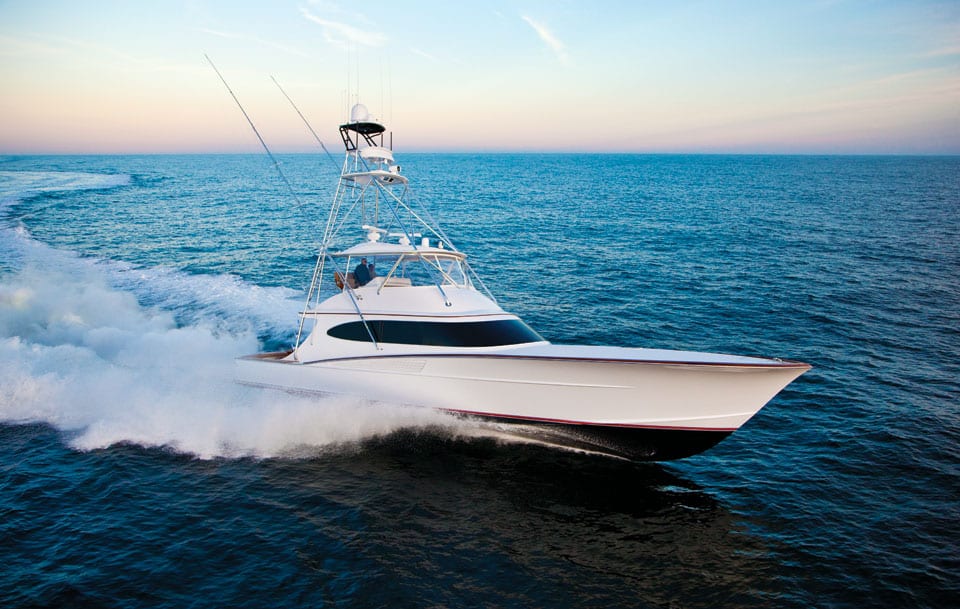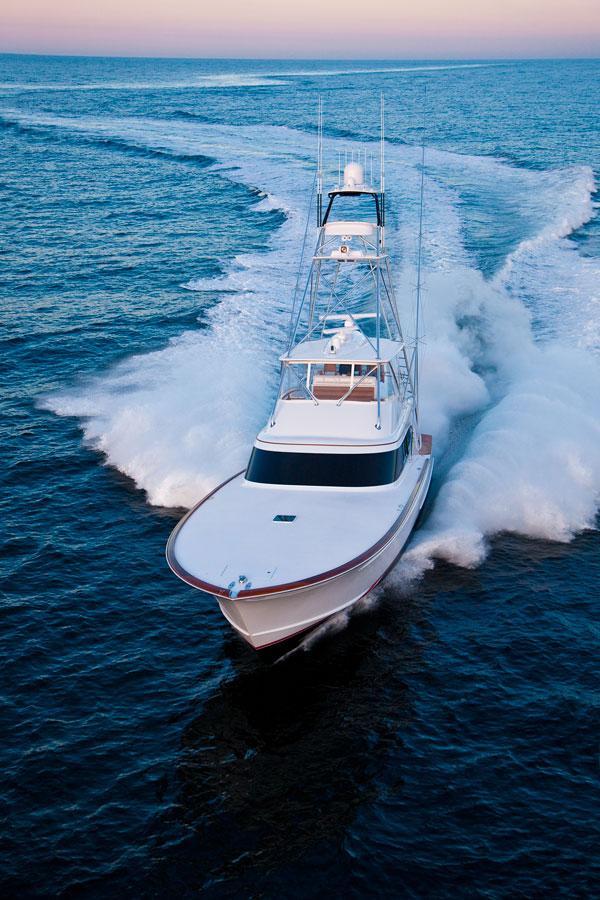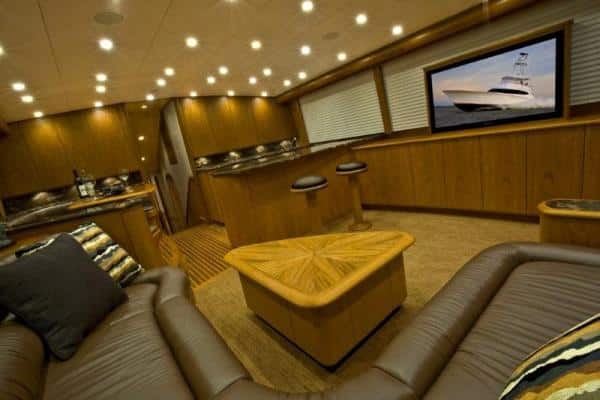
Bayliss
I have known John Bayliss since his days as a first-rate tournament skipper, and having served as an angler in his cockpit, I can tell you that he sweats the details — type triple-A! Like many good fish-boat skippers he migrated from commercial fishing to a charter boat and then to the helm of a tournament boat. As a few of the very best have done, he banked his knowledge of fishing and the sea and draws on it to build custom tournament boats. This is where tradition ends, however, because Bayliss is one of a new breed of North Carolina boatbuilders and a recent launch, Uno Mas, is one of a new breed of Carolina boats (see the complete photo gallery).
There have always been boats to build on the Outer Banks of North Carolina. Small fishing communities like Wanchese and Harkers Island still seem frozen in time, since major airports and Interstate 95 are inconvenient. Until the boom in tournament boats, the local focus was simple: stout boats built for the commercial and charter fishing trades. The boats that were built for recreational anglers remained genetically simple working designs, strip-planked and framed with juniper. By the 1980s builders began adding an exterior layer of plywood and fiberglass to “stiffen and fair things up.” A so-called charter finish was typically hand-brushed, and there might still be a bit of bark left on the frames.
South Florida tournament-boat builders came from humble beginnings as well but were jump-started by wealthy anglers who vacationed in the area. The zen of modern tournament-boat building was born in the 1950s at Rybovich & Sons Boat Works in Palm Beach. By the 1980s most charter skippers in south Florida couldn’t afford the boats they had inspired. Skippers in both Florida and North Carolina began to enlist in the growing fleet of private boats, and the modern tournament fishing boat was born. What had once been a regional sport expanded to the Bahamas and beyond. Bayliss gave up his charter boat in 1997 to run several tournament boats for production-boat companies.

Bayliss’ creations are not defined so much by regional habit as by experience on the tournament circuit. Uno Mas is Bayliss’ 11th boat since he came ashore to launch his boatbuilding business in 2002. From the start, Bayliss has worked with Florida-based naval architect Robert Ullberg. “I drew the first boat on my kitchen table and drove to Florida to sort her out with Robert,” Bayliss said. Today, sketches migrate to the computer and are modeled in 3-D. New hull designs are tank-tested, and once things are locked in, full-size patterns are cut by computer. Gone are the days when a builder “set up” a boat working from a rough pencil sketch and shaped by eye on the shop floor.
While the products of builders with long histories tend to evolve, Bayliss started with a fresh piece of paper. Uno Mas is indeed a hybrid and defies even the expert eye attempting to pigeonhole her Carolina heritage. She lacks the distinctive regional features of heavy tumblehome and strong flam or, as locals prefer, Carolina Flare. The complicated compound curves of her deckhouse and bridge are a far cry from the practical charter boats of the past, where ease of construction led to slab-sidedness and radii defined by old coffee cans. The final product is a strikingly beautiful design that is built with a respect for purpose and tradition but is thoroughly modern.
While you may still find the beginnings of a strip-plank boat poking out of a shed, boatbuilding on the Outer Banks has matured and most builders are working in cold-molded wood or foam-core fiberglass. Bayliss prefers wood, because he believes it offers the most strength for a given weight. With the performance that tournament boats are capable of and the competitive nature of captains, Bayliss points out, the challenge is to keep things together. “Our boats are like our kids. … I don’t want any phone calls in the middle of the night.” As for the mythical ability of wood in terms of raising fish: “Wood is good but the captain, mate and angler still make the difference,” says Bayliss with a competitive grin.
Instead of a repurposed steel building in a landlocked industrial park, Bayliss built a first-class construction facility and service yard on the waterfront on the southern tip of Roanoke Island in Wanchese. Bayliss has 20,000 square feet under cover, which includes a wood shop, a machine shop and a construction bay that can accommodate four boats as large as 80 feet. It’s a modern approach to an old-school custom boatbuilding model, Bayliss explains. “The economics work, so we can shift labor to where it’s needed, which helps keep continuity in our workforce — a lot of our craftsmen have been here from the beginning.”
Uno Mas was built on a disposable jig. Her hull is diagonally planked okoume plywood that is epoxy-glued and screwed — three layers on her bottom and two on her topsides. Internal support is provided by laminated fir longitudinal stringers and three-inch-thick okoume/foam sandwich bulkheads and web frames. The complex shape of her house and flybridge are crafted with an okoume/foam sandwich as well.

Interior and exterior surfaces are covered with fiberglass and epoxy and finished with a linear polyurethane coating. Interior nonstructural components are finished in veneer over foam coring. The net result is a strong, lightweight structure —_ Uno Mas_ weighs in at 85,000 pounds (dry).
As is standard practice in the building of tournament boats, Uno Mas’ machinery spaces and lazarette are faired and finished, pumps and valves are painted and stainless steel is polished. During our sea trial, her two 1,925-horsepower Caterpillar C32s delivered a top speed of 40.7 knots. These are the numbers competitive captains and anglers are looking for. “We make conservative performance predictions,” Bayliss says. “You don’t have to apologize for building a boat that’s too fast.”
Uno Mas is the most sophisticated boat Bayliss has ever launched. “The owner really wanted something special and I suppose I did too,” Bayliss admits. “We can build a darn nice tournament boat the same size with 20 percent less man-hours.” If the goal was to prove a point with Uno Mas, John Bayliss has, and in doing so he has raised the regional bar. He approaches boatbuilding with the same passion with which he fishes — type triple-A!
See the complete photo gallery.
Test Conditions: Speeds were measured by GPS off Palm Beach, Florida, in a two- to five-foot seas and 10 to 15 knot winds, with a ½ load of fuel and a ½ load of water, and four people onboard. Fuel consumption was calculated by the electronic engine-monitoring system. Sound levels were measured at the helm.
RPM Knots GPH dB(A)
600 7.5 10 72
900 11.1 28 78
1200 16.7 60 80
1500 23.5 90 84
1800 32.3 130 87
2100 36.8 175 88
2250 40.7 200 88
(max)
LOA: 68’0″
LWL: 61’0″
BEAM: 19’3″
DRAFT: 5’2″
DISPL.: 85,000 lb. (dry)
FUEL: 2,600 gal.
WATER: 450 gal.
TRANSOM DEADRISE: 13 degrees
ENGINES TESTED: 2 x 1,925 hp Caterpillar C32A diesels
BASE PRICE: Upon request
Bayliss Boatworks, 252-473-9797; www.baylissboatworks.com









